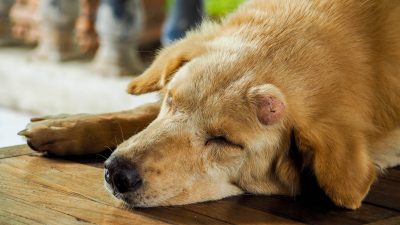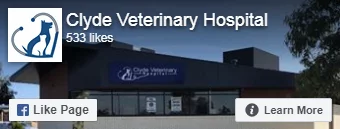By Dr Irene Mitry
Head Veterinarian – Clyde Veterinary Hospital
Unless you happen to own a Sphinx cat, the one common fact that ALL pet owners need to contend with is that your beloved companion is quite noticeably VERY FURRY.
This is great when it’s time for cuddles and pats, but we all know that fur presents its own unique problems. Their fur can tend to trap odours, house parasites and most importantly, it can obscure any emerging health conditions on your pet’s skin.
Most skin conditions are completely benign, and only represent a cosmetic threat to your pet’s well-being. But the MOST SERIOUS such conditions are very serious indeed – to the point of being life-threatening if not seen to immediately.
For this reason, it is vital for your dog or cat’s well-being that you check them regularly for any emerging issues and see your vet urgently if you find anything of concern.
That’s why at Clyde Veterinary Hospital, we strongly recommend that pet owners take just five minutes a month to perform a regular MONTHLY EXAM of their animal’s skin as part of an optimal preventative care regime, and we’ve put together this month’s blog in order to walk you step by step through the best way to do this.
1. Scheduling the Time
One of the hardest aspects of the whole exercise is actually making sure that you build this systemically into their regular care regime.
If your pet is already taking some form of monthly medication, the most obvious solution is to make sure that you routinely perform this check immediately after giving them their medication each month.
One of the great things about this check is that because of the physical attention they get, it’s one of the few veterinary exams that your dog or cat will actually come to look forward to – and if they hate their medication, this can even be a little reward for their putting up with the tablet!
If you don’t have a regular monthly routine that a skin check can become a part of, we recommend building a little reminder into your existing calendar system – fortunately most electronic systems are great for setting a regularly scheduled reminder like this. Here’s a great list of some of the most popular digital calendar apps currently on the market for this purpose.
2. Performing the Check
There is no right or wrong way to perform a lumps and bumps examination, but it is important that you systematise the check in order to make sure you’re routinely checking the entire animal.
Cancers in particular can develop in some of the harder to reach areas between joints associated with the lymphatic system.
The two key elements that make up the check are really the “technique” you use to perform it, and the “route” you map out along the animal.
In terms of the technique, it’s important to note that simply running your hands along the surface of their fur is insufficient to identify anything but the largest or most obvious problems in dogs and cats.
The point here is that this is a SKIN CHECK, and you need to make physical contact with or otherwise inspect the animal’s actual skin to perform the check effectively.
Owners will need to get comfortable with stroking their fur AGAINST its natural “grain”, so brushing BACKWARDS towards the animal’s head, rather than their tail with your fingers is the most critical aspect.
It will be much easier for short haired breeds, but you should try as best as possible to get a look at the actual skin surface, where you are looking for any unusual discolouration as well as any obvious raised lumps or disturbances of the skin.
If you identify anything unusual, make a note of EXACTLY where on your animal you found the lump or bump, and if possible take a photo of it on your phone. This will allow you to easily show the vet the area of concern and allow you to compare any changes in colour or condition of the lump.
And while it’s not technically part of a lumps and bumps check – you should make a note if you spot any fleas, ticks or other parasites in the fur or on the skin in the process, as your vet should be informed of this also at your next veterinary checkup.
3. Start the check at the head
We recommend starting your pet’s skin check with your dog or cat standing upright, with larger animals on the floor and smaller animals on a bench if possible.
You should begin the skin check at your pet’s head, remembering that their fur is shortest here so this region is particularly prone to skin cancers. Growths can be lurking absolutely anywhere.
Check their head carefully all over – for dogs remember to check the entire muzzle, look in their nostrils. around eyes, and in and around their mouth, and don’t forget to lift the earn on floppy haired breeds and have a good inspect of the under ear surface and in the ear.
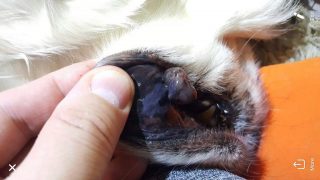
Once you’re sure you’ve covered your pet’s whole head, inspecting as much of the skin as possible, start working your way along their back to their tail, repeating the process, patting them constantly “against” the natural grain of their fur to raise it up and expose the skin before moving progressively along to the next section.
Make sure you inspect the whole tail – this is one part of the exam most pets are less than fond of, but it’s important to try and hold the tail as still as possible to allow you to at least inspect its length by touch.
You will then need to examine their underside, best done by rolling them fully on their back, and similarly inspecting their tummy fur. Pay special attention to their joints – lumps can often grow in these difficult to detect locations, and make sure you run your hands fully along all their limbs.
Conclude the exam by a close examination of the pads of all four paws, where in addition to lumps and bumps, burrs and other foreign objects can cause problems.
4. What If I Find A Lump?
Firstly, the most important thing is that you DON’T PANIC. The vast majority of lumps found on dogs or dogs turn out to be completely benign – even some quite nasty looking one. If you come across any of the following common types of lump, simply note and record the location and arrange to see your vet at the earliest possible opportunity.
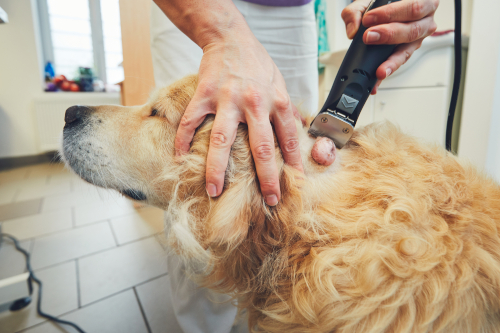
Some Common Lumps to Look Out For
Fatty Tumours – you may notice these soft, fatty lumps appearing on your pet, and largening and sagging with age. They tend to be more common in obese animals. Not all tumours are serious, but they should all be seen to.
Melanoma: a pigmented tumour which most frequency occurs on areas of the animal that are exposed to sunlight. Often initially circular, they may grow into a more blotchy shape and discolour with time. Melanomas are malignant and should be seen to by a vet as soon as identified.
Mast Cell Tumour – comprising of up to 25% of all tumours. They’re most common in dogs of middle and older age. Mast cell tumours can look like many other tumours, but they are actually a fast-growing form of cancer, so it’s vital to have them diagnosed accurately and quickly by a vet.
Sebaceous Cysts – these look like, basically are, and are of no more concern than the common pimple.
Warts – largely a cosmetic issue, you may notice these hard, dark circular areas of skin appear particularly around the animal’s mouth. They are nothing to be concerned with unless its annoying your pet or they are scratching at it.
Abscesses – the buildup of pus under the skin, usually associated with a wound to the pet, and usually painful or tender to the animal.
Hives – a rash of round, red weals on the skin that itch and swell. They are generally caused by a reaction of the skin to allergens such as bee stings. They sometimes they require treatment with steroids or antihistamines.
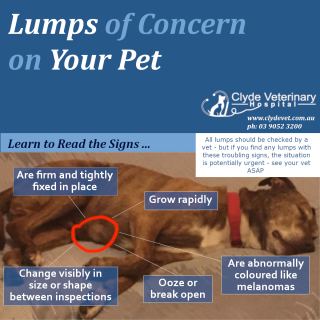
Lumps That Are Of Most Concern
As you can see, not all lumps and bumps on your pet are equally serious. For complete peace of mind, you should have anything unusual seen to by your vet, but the issue is most pressing if the lump exhibits one or more of the following features which may indicate the presence of a cancerous growth:
- Grow rapidly
- Change visibly in size or shape between inspections
- Ooze or break open
- Are firm and tightly fixed in place
- Are abnormally coloured like melanomas
Before Seeing Your Vet
Knowing the answers to these questions before you take your animal to the vet will help them diagnose your dog’s “lump” quicker
- Has the lump or bump appeared suddenly or has it been there a while?
- Has the bump or lump stayed the same consistency or had the same appearance or has it recently changed?
- Does the lump seem to separate from the underlying tissue or does it seem fixed in place?
- Is there only one lump that you have found recently or are there multiple bumps?
- Finally, has your pet shown any changes in behaviour such as loss of appetite, weight loss, vomiting, diarrhea, lethargy, or a dramatic change in overall attitude?


